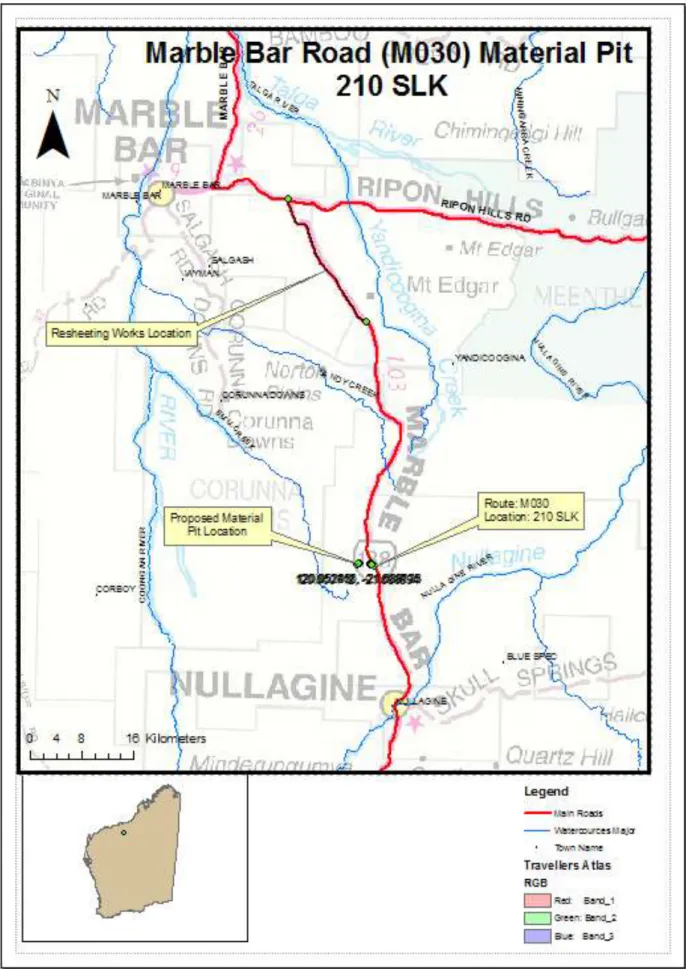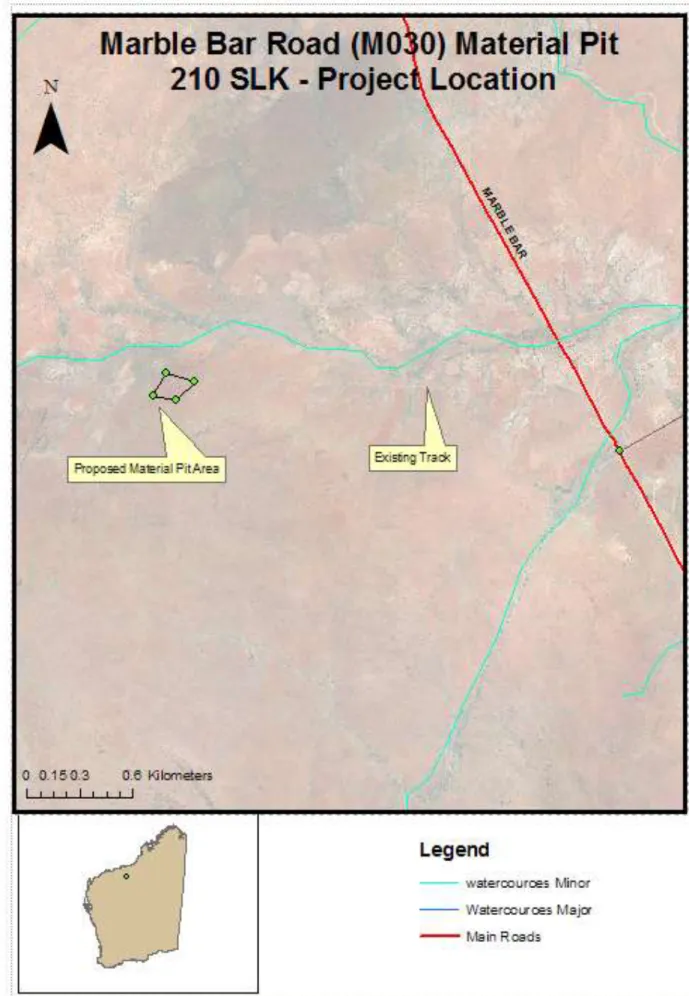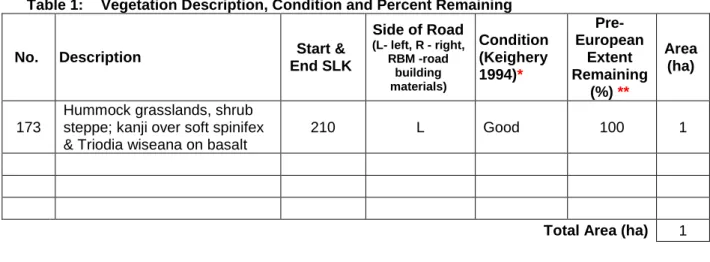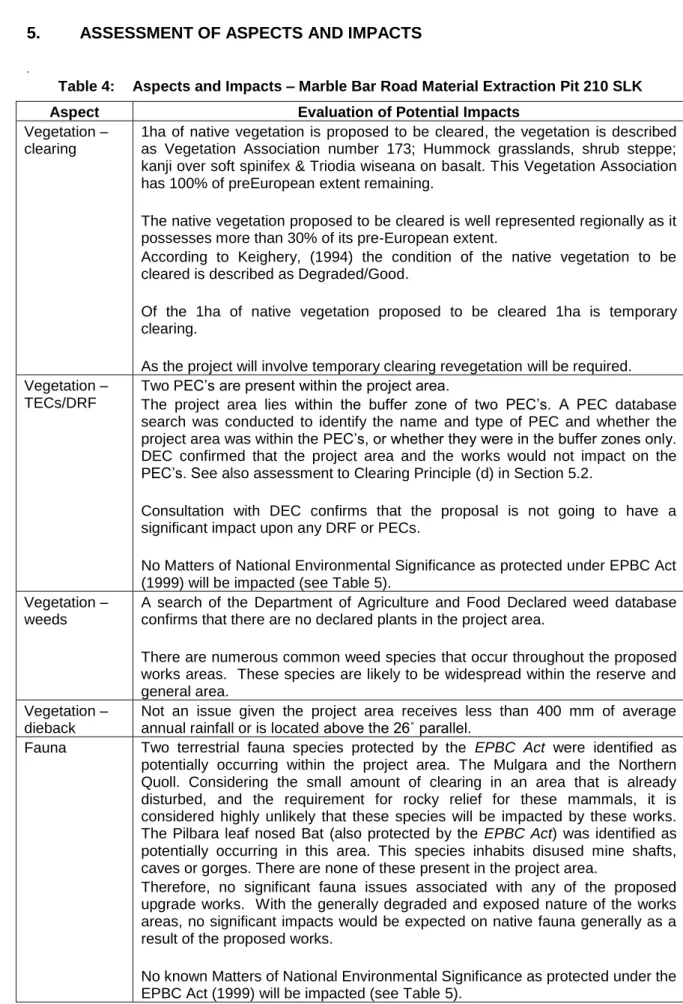The proposed Borrow Pit on the Marble Bar Road (M030) at SLK 210 is an area determined to have suitable material for proposed slab work between SLK 252 and 276 on the Marble Bar Road. The area also appears to have material suitable for use as a paving material should an opportunity for sealing arise in the future. The area is approximately 1ha in size and occurs in the Shire of East Pilbara.
The project area is approximately 24 km north of the town of Nullagine and there is access to a. The work will require the clearing of native vegetation (1 ha) occurring in the area to gain access to the suitable material. The project area occurs within two priority ecological communities (PECs) and is adjacent to a small, non-perennial stream.
Native vegetation in the area to be cleared is not considered riparian vegetation. There are no registered or pending Aboriginal Heritage sites within the project area, therefore no further surveys or approvals are required.
DESCRIPTION OF THE PROJECT
P ROJECT L OCATION
METHODOLOGY
P RELIMINARY D ESKTOP S TUDY
As the project receives <400 mm of rain and is above the 26' width, degradation is not considered to be a problem. Platform (SLIP - https://uat2.landgate.wa.gov.au/bmvf/app/waatlas/) to determine the level of risk to which the project is exposed, see Appendix J. The need for a local air quality assessment was determined based on the criteria outlined in MRWA Environmental Guideline, Air Quality.
C OMMONWEALTH R EFERRAL
S TATE R EFERRAL
EXISTING ENVIRONMENT
D ESCRIPTION
S ITE I NVESTIGATION
CLEARING OF NATIVE VEGETATION
D ETAILS OF V EGETATION A SSOCIATIONS TO BE C LEARED
A SSESSMENT A GAINST C LEARING P RINCIPLES
The native vegetation in the project area does not have a bioregional conservation status of depleted or less than 50% representation and is therefore less likely to contain endangered or other significant ecological communities. Natural vegetation to be cleared in connection with this project is not considered significant natural vegetation in the landscape for the maintenance and existence of ecological values. Given that the original vegetation in the project area associated with the vegetation association remains at 100% pre-European extent and the required clearing is only 0.7 ha, it is estimated that this area of ecological communities will remain well represented after the end of the project.
The watercourse in this area is not recognized as a carrier of indigenous vegetation that will be cleared in the project area. Clearing 1 ha of native vegetation is unlikely to result in land degradation as there will still be sufficient native vegetation in the landscape. Desktop assessment ArcGis WA Soils layer The proposal is not likely to contravene this principle.
Native vegetation should not be cleared if the clearing of vegetation is likely to have an impact on the environmental values of any adjacent or nearby conservation areas. Clearing native vegetation is not likely to require digging into (or near) the water table, so groundwater is unlikely to be affected.
S UMMARY OF M ANAGEMENT A CTIONS
Fragmentation of landscapes is unlikely to occur as a result of these works, as the works do not cross any protected areas, nor will it contribute to the maintenance or restoration of one or more key ecological processes necessary to maintain a protected area. No minor residual areas of vegetation (and their basic ecological functions) will be affected. ArcGis maps and Landgate searches were carried out to check for any conservation reserves or areas of conservation value.
Surface waters are unlikely to be affected, also due to the small scale of the proposed clearcutting. Since the project is not considered a particularly large-scale clearance and the area has already been somewhat affected by existing vehicle tracks, the clearance is unlikely to result in an increase or intensity of flooding. Indicates the assessment that the settlement may violate or violate one or more of the settlement principles.
Does the assessment indicate that clearing is inconsistent with one or more of the principles for clearing. Does the assessment indicate that the cleanup is contrary to the cleanup principle (g) land degradation, (i) surface or groundwater quality, or (j) flood incidence. Will the project include clearance for purposes deemed temporary in nature under condition 13 of CPS818.
The RMP must be submitted to the DEC Executive Director prior to settlement unless;.
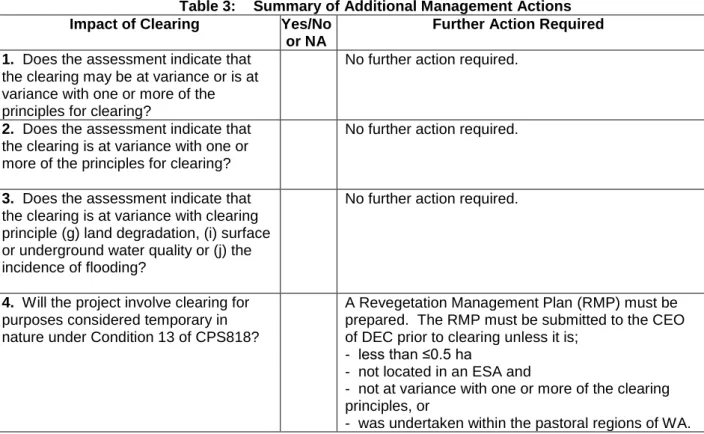
ASSESSMENT OF ASPECTS AND IMPACTS
A search of the online databases of the Inventory of Australian Heritage Sites, the Heritage Council of Western Australia and the Shire of East Pilbara Municipal Heritage Inventory has shown that there are no known site(s) of heritage significance in proximity to the project area. A search of the DIA database did not identify any known areas of Aboriginal heritage significance in the vicinity of the project site. A search of the DoW database has confirmed that the proposed works will not disturb or disrupt any natural drainage and surface runoff patterns.
No large sensitive receivers in addition to the proposed works, but excessive dust can affect vegetation. Requirements of the Shire of East Pilbara regarding noise control and construction working hours must be met. Provided that traffic management and signage are applied according to the standards of the major roads, none of the proposed works pose a significant threat to public safety.
Not relevant to the proposed works, the project does not require any hazardous substances. Contamination A search of DEC's database for contaminated sites shows that no contaminated site(s) have been identified within the project area. National Heritage Places A search of the Australian Heritage Places Inventory Database found no sites near the project.
A search by the Department of Sustainability, Environment, Water, Population and Communities Protected Matters Search Tool found no Ramsar Wetland(s) near the project. A search by the Department of Sustainability, Environment, Water, Population and Communities Protected Matters Search Tool found no endangered ecological communities, 4 endangered species, and no protected marine species near the project. The project activities are unlikely to have a significant impact on these species and the marine species are listed as "overflying" and the vegetation present is unlikely to be a habitat for these species.
A search using the search tool of the Ministry of Sustainability, Environment, Water, Population and Protected Affairs found 8 migratory species near the project. Project activities are unlikely to have a significant impact on these species as the vegetation present is unlikely to provide habitat for these species. Commonwealth Lands The project is not located on and will not affect any Commonwealth lands.
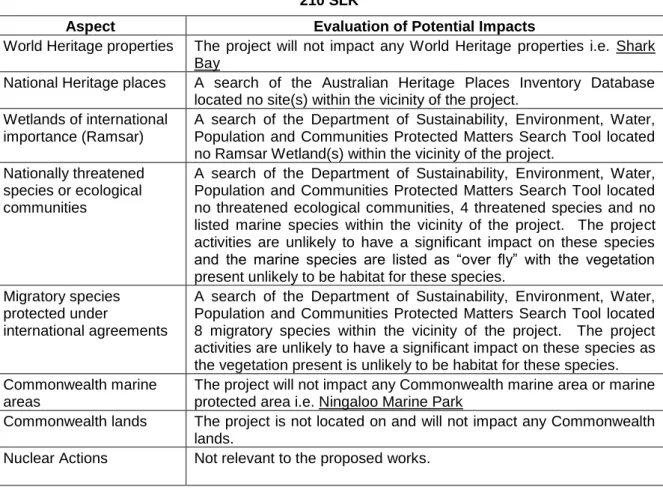
DECISION TO REFER
R EFERRAL TO THE D EPARTMENT OF S USTAINABILITY , E NVIRONMENT , W ATER ,
R EFERRAL TO THE E NVIRONMENTAL P ROTECTION A UTHORITY
STAKEHOLDER CONSULTATION
OTHER APPROVALS/PERMITS/LICENCES
Australian Heritage Places Inventory, Heritage Council of Western Australia en de Municipal Heritage Inventory Database Searches.
DEC CONTAMINATED SITES DATABASE SEARCH
The project management measures identified in this EMP are in addition to the standard environmental management contract specifications used for Category 2 projects. Hovedveje's standard environmental contract specifications (specifications and 304) must be complied with where applicable. Environmental issues specific to the project will be communicated as follows. Method Frequency Participants Reference Record Project Site.
Due to the scale and nature of the project, no emergency measures have been identified as the inherent environmental risks are small. Due to the scale and nature of the project, there is no requirement to monitor the implementation of the EMP as the environmental risks are small. Remove Vegetation Ensure that the overall objectives of the adaptation and construction work are compatible with preserving and, where possible, improving the biological integrity of the environment and minimizing vegetation loss and.
Project Manager Major road construction works will be undertaken in winter to reduce the potential for. This vegetation will be used during any rehabilitation work and will either be mulched or re-scattered as per the TDP/Revegetation plan. If the clearing is in accordance with the primary purpose permit (CPS818), ensure that you comply with section 14 of the permit regarding the control of Dieback, other pathogens and weeds.
Surface drainage Maintain the hydrological regime that existed prior to the construction of the proposal. Prior to the construction of the works, access to private property and appropriate traffic management measures must be planned and implemented. Main roads contractor Any complaints about dust will be resolved as soon as possible.
Irrigation, use of hydromulch or other forms of mulching to protect loose surfaces should be used as mitigation measures. The designated service area will be bunded to contain spills or leaks and shall not be located in an area adjacent to drainage areas or streams, or will drain into a temporary sump. All waste oil will be collected for recycling and all empty fuel/oil containers, used filters and waste hydraulic parts must be collected and stored in a designated area and then removed to an approved location.
Project areas, including hard standing areas, will be maintained in an orderly manner at all times. Contractor Main Routes A water tanker/firefighting unit will be on site at all times.
